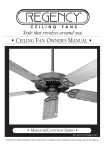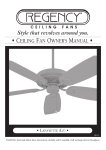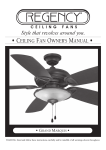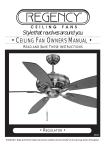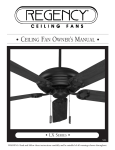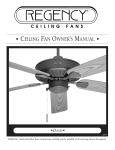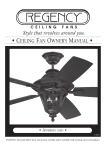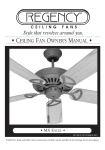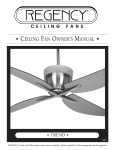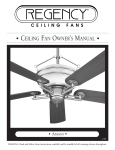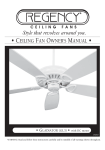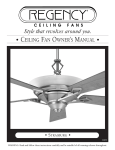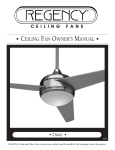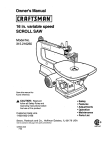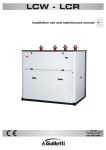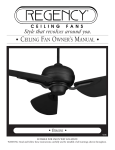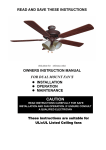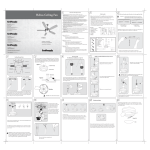Download Regency Professional Series Owner`s manual
Transcript
• Style that revolves around you. CEILING FAN OWNER'S MANUAL • • PROFESSIONAL SERIES FANS • REVISED NOVEMBER 2007 WARNING: Read and follow these instructions carefully and be mindful of all warnings shown throughout. Regency Ceiling Fan Limited Lifetime Warranty Regency extends the following warranty to the original purchaser of a Regency Ceiling Fan. 1. 2. 3. 4. 5. 6. 7. 8. If any part of your Regency ceiling fan motor fails at any time during the lifetime of the original purchaser due to a defect in material or workmanship, we will provide a replacement part free of charge, when the defective fan is returned to our corporate service department. Proof of purchase required. (See number 8 below). If your fan motor fails at any time within one (1) year after date of original purchase due to a defect in material or workmanship, labor to repair defects that cannot be made right with new replacements will be provided free of charge at our corporate service department. You will be responsible for all labor cost for repairs after this one year period. (See number 8 below). If any other part of your Regency Ceiling Fan (blades, mounting hardware, switches, capacitor, flywheel, etc.) fails at any time within one (1) year after original purchase due to a defect in material or workmanship, we will repair, or, at our option, replace the defective part free of charge for parts and labor performed at our corporate service department. (See number 8 below). No warranty, express or implied, is made in respect to light fixtures, glassware, light bulbs, or the finish on any metal, plastic, or wooden portion of the fan. Because of varying climate conditions in the United States, this warranty does not cover any changes in brass finish, including: rust, pitting, corrosion, tarnishing or peeling. Brass finishes of this type give their longest useful life when protected from varying weather conditions. This warranty is void if your fan is not purchased from an authorized Regency dealer and installed in the U.S. This warranty does not apply in case of improper installation, failure of supporting devices not supplied as original mounting hardware, neglect, accident, misuse, exposure to extreme heat, humidity, or as a result of modification to the original product. All cost of removal and reinstallation of the fan are the express responsibility of the original user/purchaser. A certain amount of “wobble” is normal and should not be considered a problem. Serving performed by unauthorized persons will render this warranty invalid. Regency reserves the right to modify or discontinue any product at any time and may substitute similar parts. If you need to return your fan to our corporate service department, a fee of $14.00 must accompany your fan to cover handling. This fee must be in the form of a check or money order made payable to REGENCY CEILING FANS. Should you require service at our corporate service department, YOU MUST FIRST WRITE FOR A RETURN AUTHORIZATION TO: Regency Ceiling Fans P.O. Box 730 Fenton, MO 63026 IMPORTANT: DO NOT SEND FAN TO P.O. BOX ADDRESS. BE SURE TO STATE COMPLETELY THE NATURE OF THE PROBLEM. Under no circumstances should a product be returned without prior authorization from Regency Ceiling Fans and then only upon the issuance of a returned goods authorization number. To avoid damage in transit, all products should be returned in the original shipping carton, as Regency will not be responsible for any such damage. Authorized returns should be shipped freight and insurance prepaid to Regency. Regency will ship repaired or replaced fan prepaid back to you. 10. A copy of the sales receipt should be sent with fan being returned as proof of purchase. Please specify in writing the nature of the problem you are having with the fan. Include your name and return address inside the carton. 11. It is agreed that any repair or replacement is the exclusive remedy from Regency. There is no other expressed warranty. REGENCY CEILING FANS HEREBY DISCLAIMS ANY AND ALL IMPLIED WARRANTIES, 9. INCLUDING, BUT NOT LIMITED TO, THOSE OF MERCHANTABILITY AND FITNESS FOR A PARTICULAR PURPOSE TO THE EXTENT PERMITTED BY LAW. The duration of any implied warranty which cannot be disclaimed is limited to the warranty period as specified in the express warranty. Some states do not allow limitation on how long an implied warranty lasts, so the above limitation may not apply to you. Regency Ceiling Fans shall not be liable for incidental, consequential, or special damages arising out of/or in connection with product use or performance except as may otherwise be accorded by law. This warranty gives you special legal rights and you may also have other rights which vary from state to state. This warranty supersedes all prior warranties. Date of Purchase Model Number Store Purchased LCWC-VISLT 1/00 GENERAL INSTALLATION & OPERATION INSTRUCTIONS IMPORTANT SAFEGUARDS: 1. To ensure the success of the installation, be sure to read the instructions and review the diagrams thoroughly before beginning. 2. To avoid possible electric shock, be sure electricity is turned off at the main power box before wiring. All electrical connections must be made in accordance with local codes, ordinances and/or the National Electric Code. If you are unfamiliar with the methods of installing electrical wiring and products, secure the services of a qualified and licensed electrician as well as someone who can check the strength of the supportive ceiling members and make the proper installation(s) and connections. 3. Make sure that your installation site will not allow rotating fan blades to come in contact with any object. Blades should be at least 7 feet from floor when fan is operating. 4. If possible, mount ceiling fan on a ceiling joist - the joist must be able to support the motion and weight of the moving fan. If the fan will be mounted on a ceiling outlet box, an approved box UL listed as “suitable for fan support” is required. The box and its supporting members must be able to support the moving weight of the fan (at least 35lbs.). The box must not be able to twist or work loose. Installation on a concrete ceiling should be performed by qualified personnel. 5. Blades should be attached after motor housing is hung and in place. Fan motor housing should be kept in the carton until ready to be installed to protect its finish. If you are installing more than one ceiling fan, make sure that you do not mix fan blade sets, as each blade is part of a weighted set. 6. After making electrical connections, spliced conductors should be turned upward and pushed carefully up into outlet box. The wires should be spread apart with the common conductor and the grounding conductor on one side of the outlet box, and the “HOT” wires on the other side. 7. Electrical diagrams are for reference only. Light kits that are not packed with the fan must be UL listed and should be installed per the light kit’s installation instructions. 8. After fan is completely installed, check to make sure that all connections are secure to prevent fan from falling and/or causing damage or injury. 9. The fan can be made to work immediately after installation - the bearings are adequately charged with grease so that, under normal conditions, further lubrication should not be necessary for the life of the fan. 10. The fan should be turned off and allowed to stop rotating before reversing fan direction. 1 IMPORTANT SAFETY PRECAUTIONS Thank you for choosing a Regency Ceiling Fan. You have chosen the best! Your new ceiling fan has been designed to provide many years of service and enjoyment. Warnings: • Disconnect power by removing fuse or turning off circuit breaker before installing the fan and/or optional lighting. Support directly from building structure. • To reduce the risk of fire, electric shock, or personal injury, mount to outlet box marked “acceptable for fan support” and use mounting screws provided with the outlet box. Most outlet boxes commonly used for the support of lighting fixtures are not acceptable for fan support and may need to be replaced. Consult a qualified electrician if in doubt. • To reduce the risk of fire, electrical shock, or personal injury, only use this fan with an appropriate speed control device designed for use with ceiling fans, if you choose a wall control. DO NOT USE A SIMPLE INCANDESCENT LIGHT DIMMER. Do not use this fan with any transformer type fan speed control device. • To reduce the risk of personal injury, do not bend the blade arms when installing them, balancing the blades or cleaning the fan. Do not insert any objects(s) between rotating fan blades. NOTE: The important precautions, safeguards and instructions appearing in this manual are not meant to cover all possible conditions and situations that may occur. It must be understood that common sense, caution and carefulness are factors which cannot be built into this product. These factors must be supplied by the person(s) installing, caring for, and operating the unit. TOOLS AND MATERIALS REQUIRED • Phillips screwdriver • Blade screwdriver • Wrench or pliers • Wire cutter • Stepladder • Wiring supplies as required by electrical code 2 UNPACKING YOUR FAN 1. Unpack your fan and check the contents. Do not discard the carton. If warranty replacement or repair is ever necessary, the fan should be returned in original packing. Remove all parts and hardware. Do not lay motor housing on its side, or the decorative housing may shift, be bent or damaged. 2. Examine all parts. You should have the following: 2 1 6 9 3 10 7 4 11 8 5 1. 2. 3. 4. 5. 6. 7. 8. 9. 10. 11. 12. 12 Fan blades (5) (Packed in separate box.) Hanging bracket Ceiling canopy Downrod/ball assembly Decorative collar cover Fan housing with motor (Remove rubber shipping supports around motor, if included on your fan. Save screws.) DetachableSwitch housing Blade arms (5) Pull chain with fob Bracket mounting hardware (wood screws, screws, lock washers, washers, wire nuts) Blade arm to blade screws, w/washers (15) "S" hook (Used for hugger style mounting.) NOTE: Design of parts shown above may look slightly different for your specific model of fan. REVISED NOVEMBER 2007 2 PREPARATION Parts identification on assembled fan Canopy Downrod Blade Motor Housing Blade Arm Light Kit PREPARATION: Verify you have all parts before beginning the installation. Check foam insert closely for missing parts. Remove motor from packing. To avoid damage to finish, assemble motor on soft padded surface or use the original foam inset in motor box. Do not lay motor housing on its side as this could result in shifting of motor in decorative enclosure. INSTALLING THE MOUNTING BRACKET Caution: To avoid possible electrical shock, be sure electricity is turned off at the main power box before wiring. All wiring must be in accordance with National and Local Ceiling Fan Outlet Box Electrical Codes and the ceiling fan must be grounded as a precaution against possible electric shock. 1. Locate ceiling joist where fan is to be mounted, being sure location agrees with the requirements in the minimum clearance section of this guide. Wood joist must be sound and of adequate size to support 35 lbs. (See Page 1, Items 3 and 4). Hanger Bracket 2. If not already present, mount a UL listed outlet box marked “suitable for fan support” following the instructions provided with the outlet box. The outlet box must be Flat Washer Spring Washer able to support a minimum of 35 pounds. 3. Attach hanger bracket to outlet box using screws provided with the outlet box. 4 Outlet Box Screw INSTALLING THE FAN INSTALLATION: This fan has two installation options: #1 HUGGER MOUNTING The HUGGER method is preferred if maximum headroom is required. The ceiling must be horizontal, not sloped. Blades will be approximately 8˝ from the ceiling. Air flow will be reduced when the fan is installed using the HUGGER method. #2 DOWNROD MOUNTING This is the recommended mounting for ceilings 8´ and higher. The DOWNROD MOUNTING method is preferred if the ceiling is sloped or vaulted, or if the ceiling is extra high and requires the use of an extension downrod. Blades will be approximately 12˝ from ceiling using supplied downrod. 5 INSTALLING THE FAN - HUGGER STYLE INSTALLATION OPTION #1: HUGGER STYLE MOUNTING NOTE: The S hook is to be used for hugger style mounting. 1. Remove the plastic trim ring from the canopy to expose the 6 mounting holes. The downrod, ball and cotter pin will not be used for this mounting (Fig. 1). 2. Feed fan wires through the canopy and position the canopy over the mounting collar on top of the fan. The collar's 2 security screws will not be used and can be turned all the way into the collar to make attaching the canopy easier. 3. Align the canopy on top of the fan so the 3 large holes are over the 3 screws holding the collar to the fan. The 3 small holes will then be aligned with the 3 open holes in the top of the fan. 4. Securely attach the canopy to the top of the fan using the 3 hugger mounting screws provided. WARNING: To avoid damaging the blade arms and blades, do not install them onto fan until fan is fastened to ceiling. 5. Place the S hook onto the hanger bracket. Hang the canopy (with the fan motor housing attached) from the S hook on the hanger bracket using one of the holes in the edge of the canopy (Fig. 2). This will permit you to make the electrical connections without having to hold the fan up as well. 6. Make the wire connections as described in "Electrical Connections" (page 9). 7. Insert 2 screws into the hanger bracket, leaving them partially out (Fig. 3). 8. Attach the canopy to the hanger bracket by inserting the slotted openings of the canopy on the hanger bracket screws (Fig. 4), and turn the fan to the right to engage the screws in the slots. 9. Insert the 2 remaining screws through the remaining canopy holes and tighten all 4 screws. Fig. 1 Fig. 2 Screws S Hook 6-hole Canopy Motor Housing Fig. 3 REVISED NOVEMBER 2007 6 Fig. 4 INSTALLING THE FAN – DOWNROD STYLE INSTALLATION OPTION #2: DOWNROD STYLE MOUNTING 1. Carefully support fan body (motor) in its styrofoam packing with the mounting collar (where the wires come out) facing upward. 2. Remove ball from downrod by loosening set screw in the side of the ball. Slide ball down and remove ball pin; remove ball. 3. Feed the wires from top of fan through end of downrod and set end of downrod into mounting collar so the hole in the downrod lines up with the hole in the side of the mounting collar. 4. Insert downrod pin through holes in mounting collar and downrod; slip cotter pin through small hole in end of downrod pin to hold downrod in place. 5. Tighten security screws against downrod using a large flat blade screwdriver to ensure a tight fit against downrod. Tighten nuts against mounting collar. NOTE: Fan has 6 feet of hook-up wire in case you are using a long extension downrod. Wires can be cut so only 8 inches or so extend beyond the top of the downrod to make the electrical connections easier and safer. Hook-up (3) Wires Ground Wire Ball Canopy 6. Feed wires through canopy and slide canopy over downrod. It will be attached to ceiling later. Trim Ring Downrod (Optional extension shown) 7. Feed wires through ball and slide ball over downrod, past hole in the top end of the downrod. Insert ball pin (removed in step 2), slide ball up, and tighten set screw to secure ball in place. Mounting Collar Downrod Pin Top of Fan Body 7 Security Screws Cotter Pin INSTALLING THE FAN – DOWNROD STYLE INSTALLATION OPTION #2: DOWNROD STYLE MOUNTING (CONT.) 1. Lift ball/downrod/fan into hanger bracket opening. NOTE: The tab opposite hanger bracket opening should fit in slot on ball. 2. Make wire connections, (refer to section titled “Electrical Connections”). 3. Slide canopy up and fasten to hanger bracket with 4 screws provided. WARNING: To avoid damaging the blade arms and blades, do not install them onto fan until fan is fastened to ceiling. 8 ELECTRICAL CONNECTIONS ELECTRICAL CONNECTIONS: * Be sure electricity is turned off at the main power box before wiring 1. Four wires are connected to the fan. Black – this is the “hot” power to run fan. White – this is the “common” power to run fan and light. Blue – this is the “hot” power for light kit. Green – ground wire (on bracket or downrod). 2. If fan and light are to be connected to the same circuit, black and blue wires can both be connected to house circuit black wire. NOTE: The other end of the blue wire, (light circuit) is in the switch housing with a wire nut and label for light kit attachment. The white wire (common for light kit) is also there. WARNING: If light kit is not used, DO NOT connect blue wire at the ceiling. 9 BLADE ATTACHMENT BLADE ATTACHMENT: 1. Place fiber washer on screw. Insert this assembly through the blade and start the screw into the blade arm. Repeat this procedure without tightening the screw until all 3 screws have been started into the blade arm (Fig. 1). NOTE: Fans that have painted finishes are packed with gaskets that can be used between the blade arm and blade to help prevent a clicking noise that may develop if blade screws loosen over time. 2. Tighten each screw starting with center screw. 3 Fasten blade assembly to motor with provided screws and metal lockwashers. Repeat procedure for remaining blades (Fig. 2). Make sure screws are TIGHT! Loose motor screws can contribute to unnecessary hum and wobble during operation. NOTE: Cordless power screw- Install gasket between arm and blade drivers are NOT recommended, as blade (optional) they tend to strip the heads of the screws and usually will not fully compress the spring washers on the motor screws. Use a large flat blade screwdriver for final tightening to fully compress the spring washers. This will help ensure proper alignment of the blades and noise-free, Fig. 1 wobble-free running. Screw Fiber Washer Blade Arm Blade Blade assembly Blade to motor screw and metal lock washer 10 Fig. 2 INSTALLATION OF REMOVABLE SWITCH HOUSING NOTE: Be sure the power is off before installing. 1. Loosen the 3 side screws on switch housing hub halfway. 2. If installing light kit, carefully remove light kit plug in bottom of switch housing. Attach light kit to switch housing per instructions supplied with light kit. See “Electrical Connections” for hook-up of light kit. 3. Connect the plug and receptacle and make sure side buckle snaps in place. 4. Attach the switch housing to the switch housing hub. Be sure to align the opening on the edge of switch housing hub with reverse switch. 5. Align the side screws with keyhole slots on edge of switch housing and tighten the side screws. 6. Turn the power on. Your Regency Ceiling Fan is now ready to enjoy! Switch Housing Hub (bottom of motor) Opening for Reverse Switch Side Screw (x3) Connector (receptacle) Connector (plug) with Side Buckle Switch Housing Keyhole Slot (x3) Pull Chain Optional Light Kit screws into bottom of Switch Housing Reverse Switch 11 INSTALLATION OF LIGHT KIT NOTE: Before installing the switch housing to the fan, the light fixture should be installed onto the switch housing. 1. Remove the plug on the bottom of the switch housing so the light fixture can be connected. 2. Install the light fixture onto the switch housing and secure it with the lock nut provided. 3. After installation of the light fixture, connect the wire from the fixture to the switching. The wires in the switch housing are marked for LIGHT. 4. Install the switch housing onto the mounting hub of the fan and secure it with the screws provided. After the installation of the switch housing, the globe may be installed. 5. Install the light bulbs, using the correct wattage per rating. 6. Install the shade and secure it to the fixture with the mounting hardware provided. 7. Adjust the glass position so the chain from the switch housing will line up with the hole in the glass and secure. 12 OPERATION Turn on the power and check operation of the fan. The fan is controlled by the use of the pull chain as follows: one pull = high speed two pulls = medium speed three pulls = low speed four pulls = off For proper functions, ensure that the chain is pulled down fully and released each time. NOTE: Leave pull chain switch in “high speed” position when using optional wall control. The slide switch on the side of the switch housing controls forward or reverse rotation. Make sure switch is not stuck between forward and reverse positions. IMPORTANT: To prevent damage or cause injury, be sure that fan is switched to off and blades have stopped moving completely before attempting to change direction of rotation. Forward/Reverse Direction: Forward is a counterclockwise rotation of the blades when viewed from beneath the fan. This will create a downward breeze that can be felt below the fan. This is the normal direction for the fan to run when the weather is warm. WARM MONTHS Forward (counterclockwise) Reverse (clockwise) will draw air up through the blades and towards the ceiling, down the walls, and into the living space during the cooler months. COOL MONTHS Reverse (clockwise) 13 CARE AND CLEANING Periodic cleaning of your new ceiling fan is about the only maintenance that is needed. Only use a soft brush or lint free cloth to avoid scratching the finish. DO NOT use water when cleaning your ceiling fan. It could damage the motor or the wood blades and/or create the possibility of electrical shock. Periodically it may be necessary to re-tighten blade to blade arm screws or blade arm to motor screws to prevent clicking or humming sound during operation. This is especially true in climates with broad temperature and humidity ranges and in fans with painted or high gloss blades. When dusting the blades, you must support the blade to prevent bending – no pressure should be applied to the blades. If you experience any flaws in the operation of your fan, please check the following points: TROUBLESHOOTING - IN CASE OF DIFFICULTY CAUTION: Switch off power supply before carrying out any of these checks. 1. If fan will not start: Check main and branch circuit breakers and/or fuses. Check line wire connections to fan and switch housing wiring. Make sure forward/reverse switch is set to one or the other position, not stuck in between. 2. If fan is noisy: Check and make sure that all screws in motor housing are snug (but not over tight). Check that the screws securing blade brackets to the motor are tight. Check that wire connectors in switch housing are not rattling against each other or the interior wall of the switch housing. Check that all glassware is finger tight and that bulb(s) are well held in the sockets, if a light kit is used. Check that the canopy is firmly attached to hanging bracket and not vibrating against ceiling. 3. If fan wobbles: Check that all blades are firmly screwed into blade arms. Check that all blade arms are firmly secured to the motor. Make sure that the light kit (if present) is firmly attached to switch housing and that all glassware and shades are fastened properly. Wobble can also result from even the smallest deviations in distance from blade tip to blade tip - if measurements from blade tip to blade tip are not equal, loosen screws connecting blade to bracket one at a time and adjust blade(s) so that distances are equal. Interchanging adjacent blades may redistribute mass and result in smoother operation. Blade arms can be bent slightly to restore same pitch to all blades if a blade is different than the other blades when viewed edge on. 14 THANK YOU FOR PURCHASING A REGENCY CEILING FAN. Write to us at: Regency Ceiling Fans P.O. Box 730 Fenton, MO 63026 Visit us on the Web at: www.regencyfan.com 7/06 Regency Ceiling Fans

















